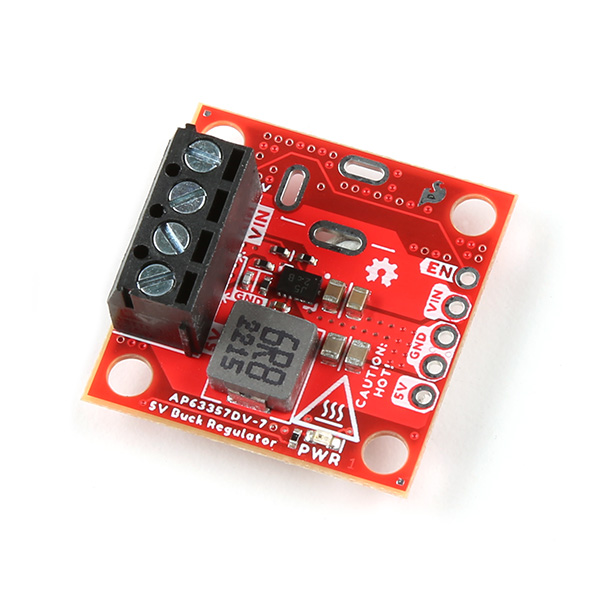SparkFun Buck Regulator Breakout - 5V (AP63357)
The SparkFun 5V Buck Regulator Breakout features the AP63357 from Diodes Inc., a 3.5A synchronous buck converter with a wide input voltage range of 3.8V to 32V. The fully integrated 74mΩ high-side power MOSFET/40mΩ low-side power MOSFET provides a high-efficiency step-down DC/DC conversion.
This full-size, 1in. x 1in. version of our buck regulator boards is configured to provide a regulated 5V output (from a 6 to 32V input voltage range) and features a high-voltage EN (enable) control pin that is rated up to 32V. On the back of the board, a small copper pad is available to dissipate excess heat with a heat sink.
As a full-size buck regulator breakout, additional options for connecting input and output power. There is a pre-assembled screw terminal for a non-permanent connection, the option to solder on a barrel jack for an external power supply, and five PTH pins to create a more permanent installation. Our full-size buck regulators also come with a red, power indication LED that light up when the power output is enabled and two mounting holes compatible with 4-40 hardware.
Check out our BabyBuck regulators and the SparkFun BabyBuck Regulator Breakout - 5V (AP63357), for the smaller minimalistic versions of our buck regulators.
Note: While the AP63357 is rated up to a 3.5A output, users should expect a 3A maximum with our boards due to thermal constraints. The boards can output 3.5A but would require a sufficient amount of active cooling.
Buck Board:
- 1in. x 1in. PCB layout
- Three power input/output options:
- Pre-assembled 4-pin screw terminal
- Five 0.1in. spaced PTH pins
- Three plated slots for a DC barrel jack (input only)
- Power connections:
VIN- Power In (6V to 32V)GND- Common GroundVOUT- Power Out (Regulated 5V)EN- Enable (Pull high to enable the power output)
- Red, power LED indicator
- 0.5in. x 0.6in. Plated copper pad (for heat sinks)
AP63357:
- VIN 3.8V to 32V
- 3.5A Continuous Output Current
- 0.8V ± 1% Reference Voltage
- 22µA Low Quiescent Current (Pulse Frequency Modulation)
- 450kHz Switching Frequency
- Supports Pulse Frequency Modulation (PFM)
- Up to 86% Efficiency at 5mA Light Load
- Proprietary Gate Driver Design for Best EMI Reduction
- Frequency Spread Spectrum (FSS) to Reduce EMI
- Low-Dropout (LDO) Mode
- Power Good Indicator with 5MΩ Internal Pull-up
- Precision Enable Threshold to Adjust UVLO
- Protection Circuitry
- Undervoltage Lockout (UVLO)
- Output Undervoltage Protection (UVP)
- Cycle-by-Cycle Peak Current Limit
- Thermal Shutdown
SparkFun Buck Regulator Breakout - 5V (AP63357) Product Help and Resources
Core Skill: Soldering
This skill defines how difficult the soldering is on a particular product. It might be a couple simple solder joints, or require special reflow tools.
Skill Level: Noob - Some basic soldering is required, but it is limited to a just a few pins, basic through-hole soldering, and couple (if any) polarized components. A basic soldering iron is all you should need.
See all skill levels
Core Skill: DIY
Whether it's for assembling a kit, hacking an enclosure, or creating your own parts; the DIY skill is all about knowing how to use tools and the techniques associated with them.
Skill Level: Noob - Basic assembly is required. You may need to provide your own basic tools like a screwdriver, hammer or scissors. Power tools or custom parts are not required. Instructions will be included and easy to follow. Sewing may be required, but only with included patterns.
See all skill levels
Core Skill: Programming
If a board needs code or communicates somehow, you're going to need to know how to program or interface with it. The programming skill is all about communication and code.
Skill Level: Rookie - You will need a better fundamental understand of what code is, and how it works. You will be using beginner-level software and development tools like Arduino. You will be dealing directly with code, but numerous examples and libraries are available. Sensors or shields will communicate with serial or TTL.
See all skill levels
Core Skill: Electrical Prototyping
If it requires power, you need to know how much, what all the pins do, and how to hook it up. You may need to reference datasheets, schematics, and know the ins and outs of electronics.
Skill Level: Competent - You will be required to reference a datasheet or schematic to know how to use a component. Your knowledge of a datasheet will only require basic features like power requirements, pinouts, or communications type. Also, you may need a power supply that?s greater than 12V or more than 1A worth of current.
See all skill levels
Comments
Looking for answers to technical questions?
We welcome your comments and suggestions below. However, if you are looking for solutions to technical questions please see our Technical Assistance page.
Customer Reviews
No reviews yet.





There should have been pads provided to short EN to Vin.